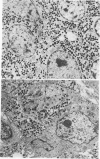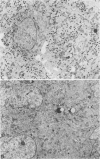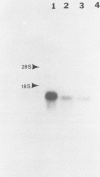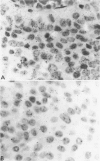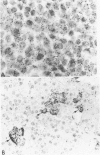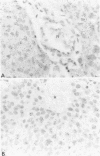Abstract
The distribution of pro-opiomelanocortin (POMC) messenger RNA (mRNA) in 7 functional and 17 clinically silent corticotropic adenomas was analyzed by in situ hybridization (ISH) with 35S-labeled oligonucleotide probes using formalin-fixed paraffin-embedded tissue sections cut from blocks that were in storage between 1 to 14 years. All 7 functional adenomas and 4 subtype 1 tumors had detectable POMC mRNA, while 3 of 6 subtype 2 and 1 of 7 subtype 3 silent adenomas contained detectable POMC mRNA. In situ hybridization analysis with an 35S-labeled beta-actin probe showed a positive hybridization signal in 22 of 22 cases, indicating that the absence of detectable POMC mRNA in some adenomas was not due to loss of the mRNAs during processing of the tissues or because of the age of the embedded tissue blocks. Northern hybridization analysis with the oligonucleotide probes in 2 normal pituitaries and an adenoma causing Cushing's disease detected a 1.2-Kb mRNA in all three tissues, indicating that the oligonucleotide probes were very specific. These results indicate that subtype 1 silent adenomas and clinically active adenomas associated with Cushing's disease contain POMC mRNA that is readily detectable by ISH in routinely processed tissue specimens, while only a few of the subtypes 2 and 3 adenomas have POMC mRNA that can be detected in paraffin blocks with the oligonucleotide probes used in this study.
Full text
PDF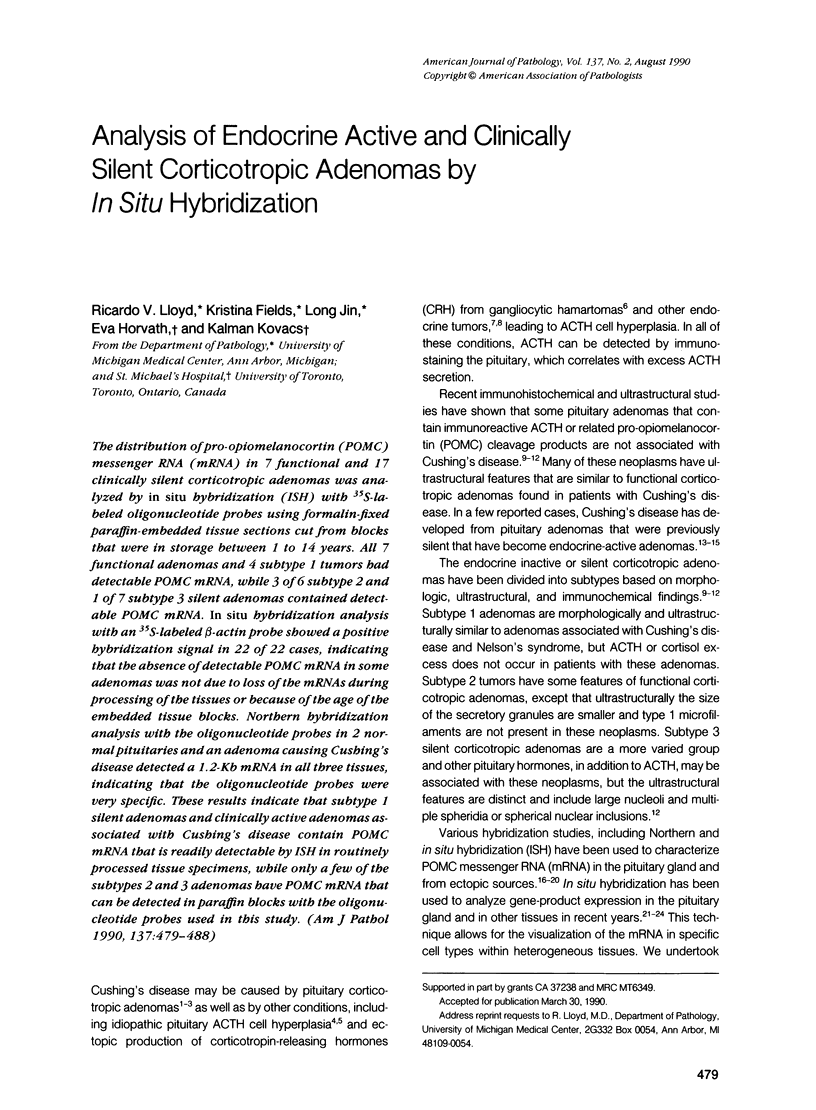
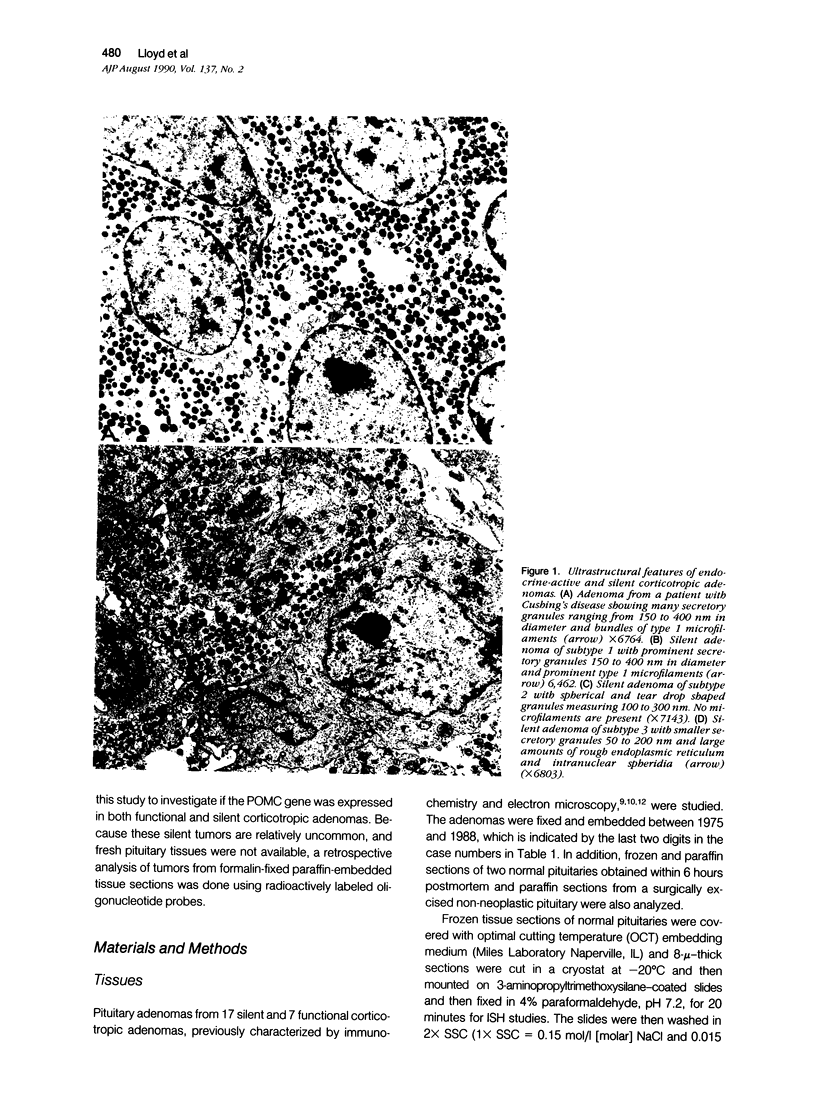
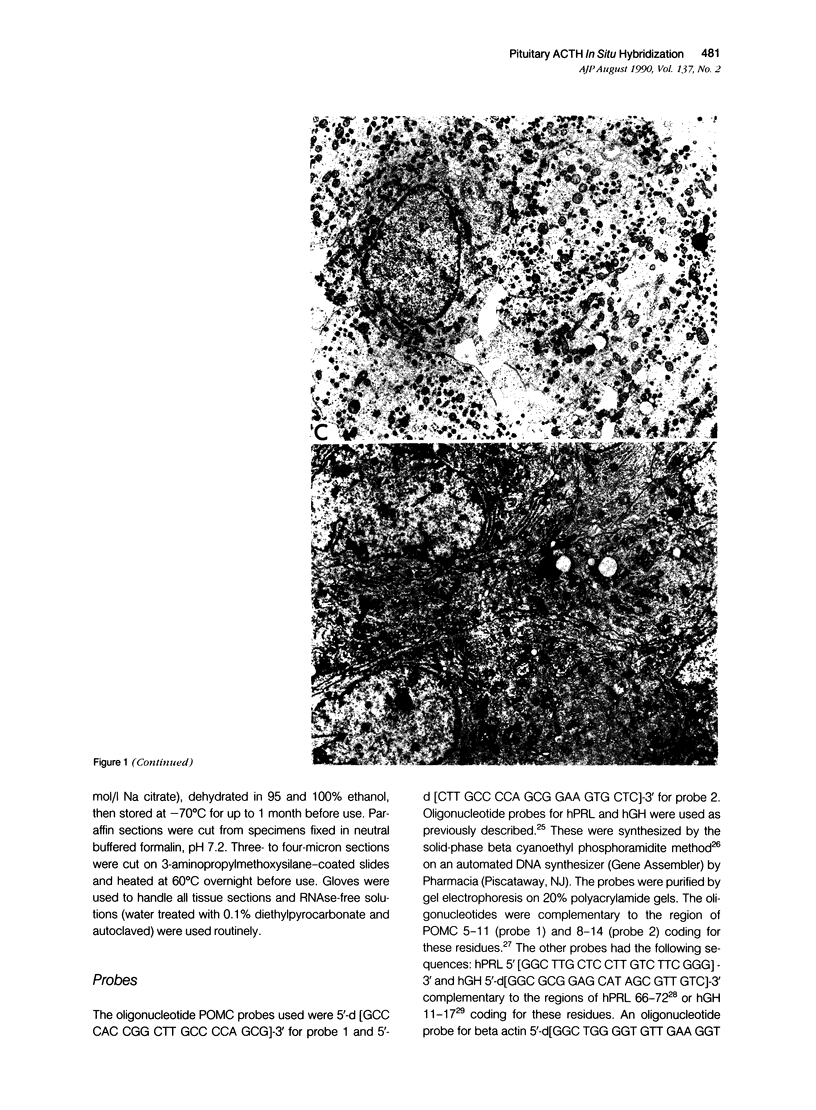
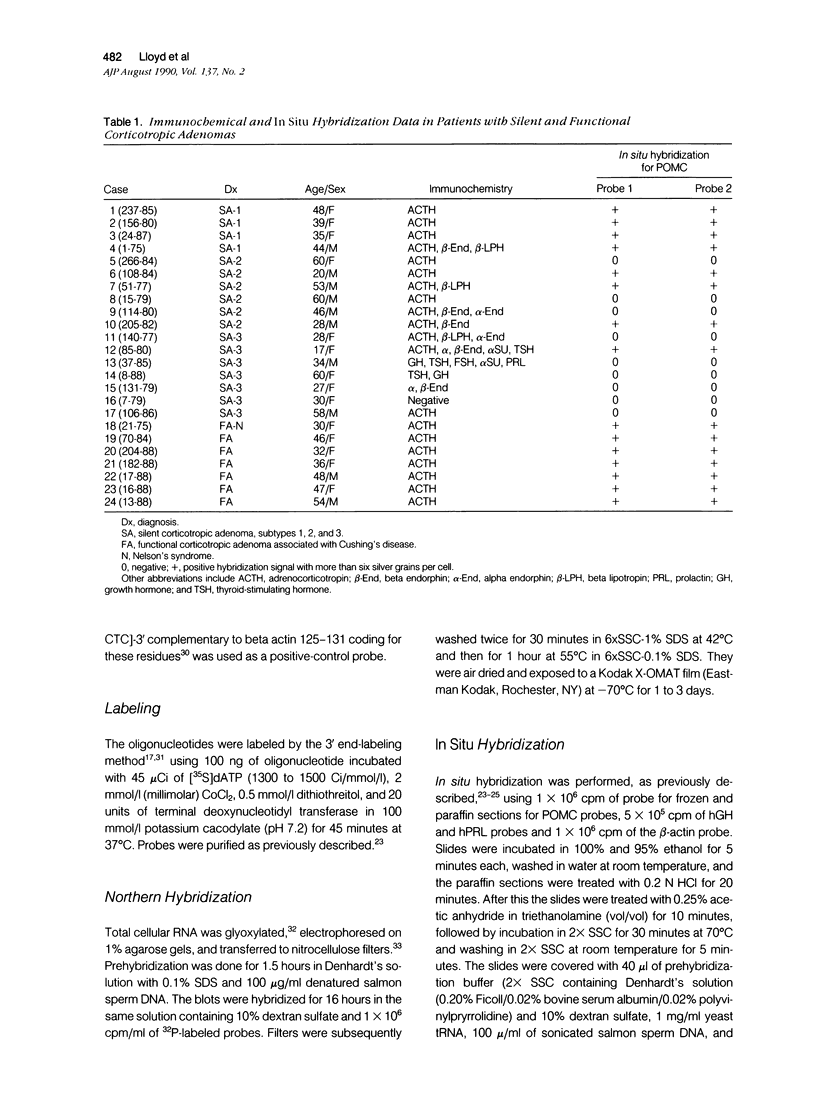
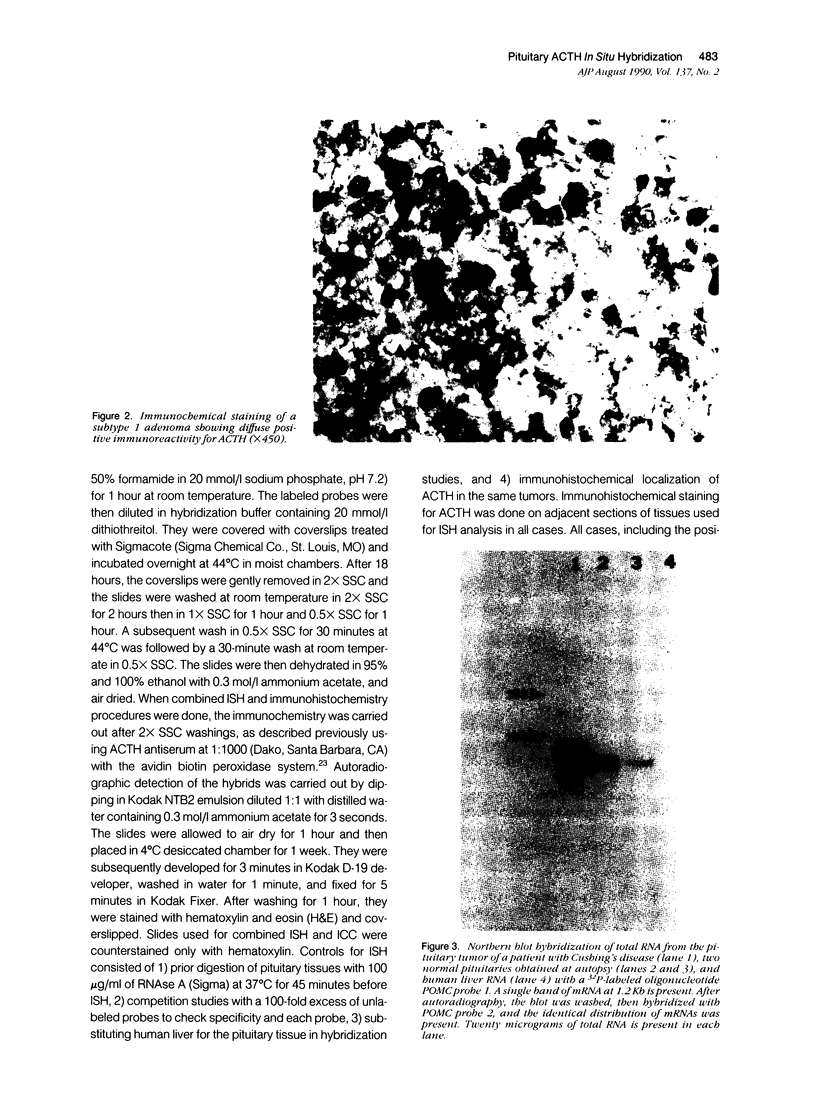
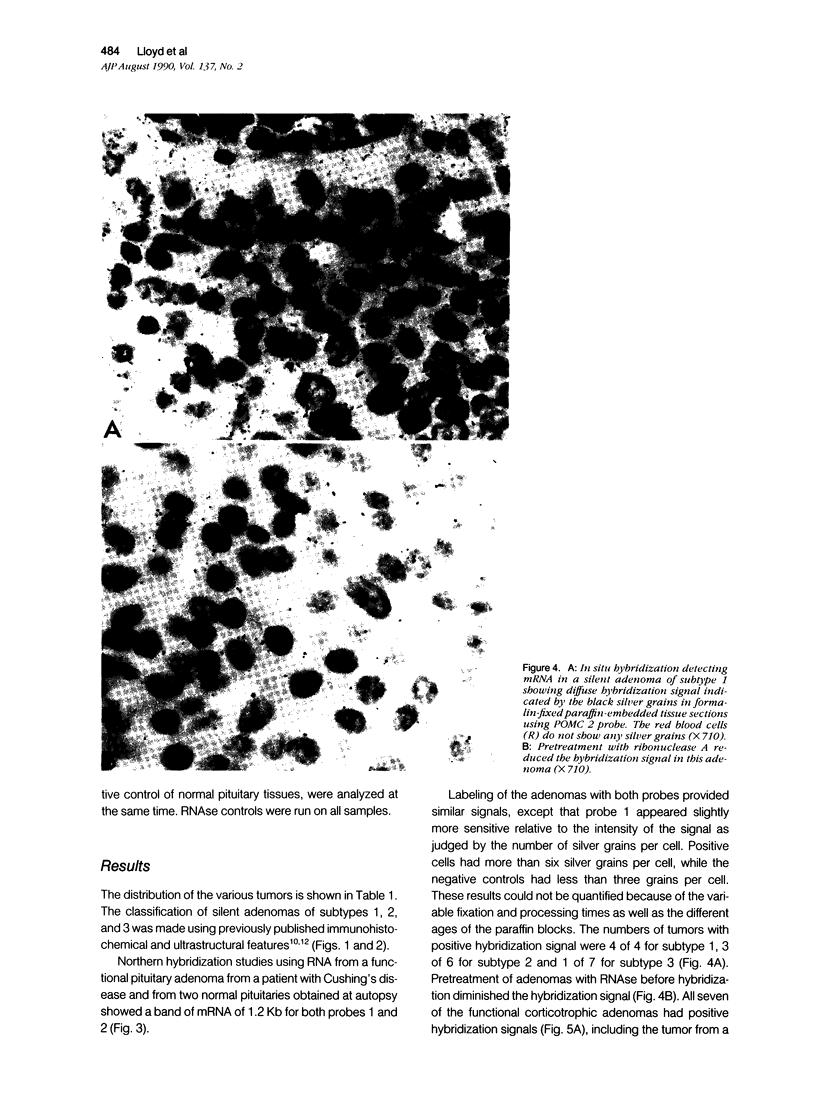
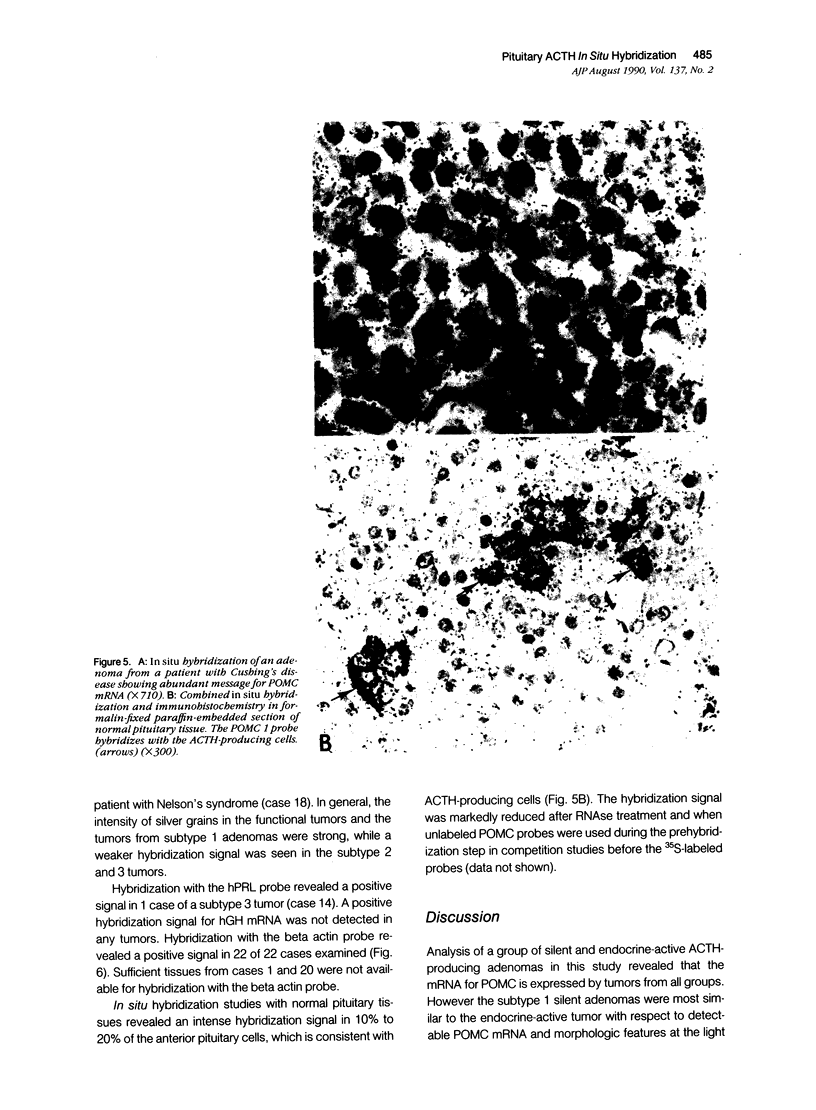
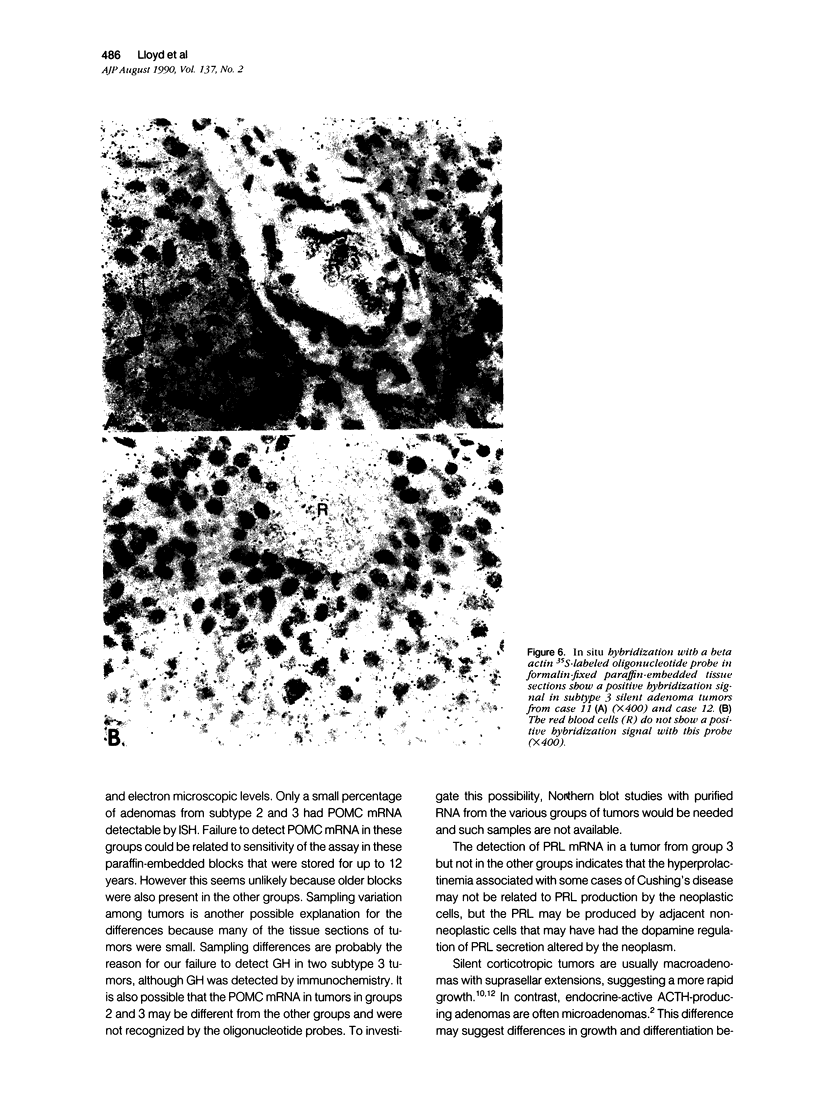
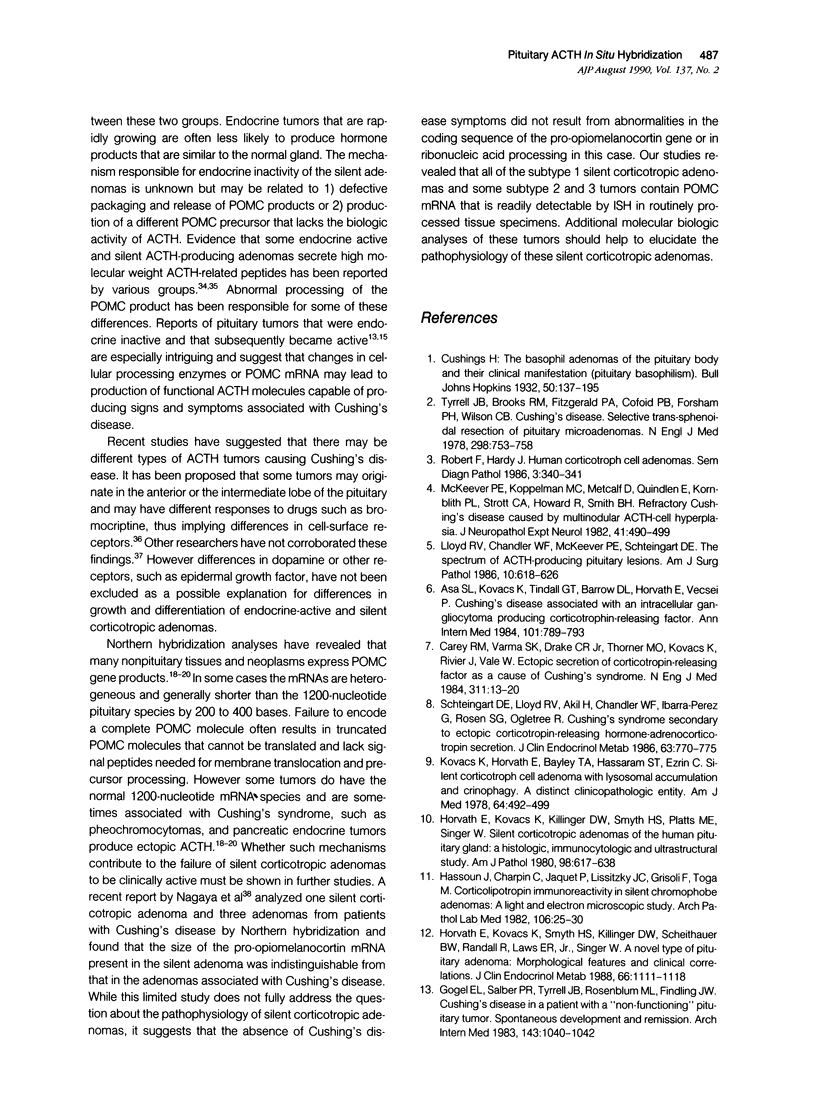
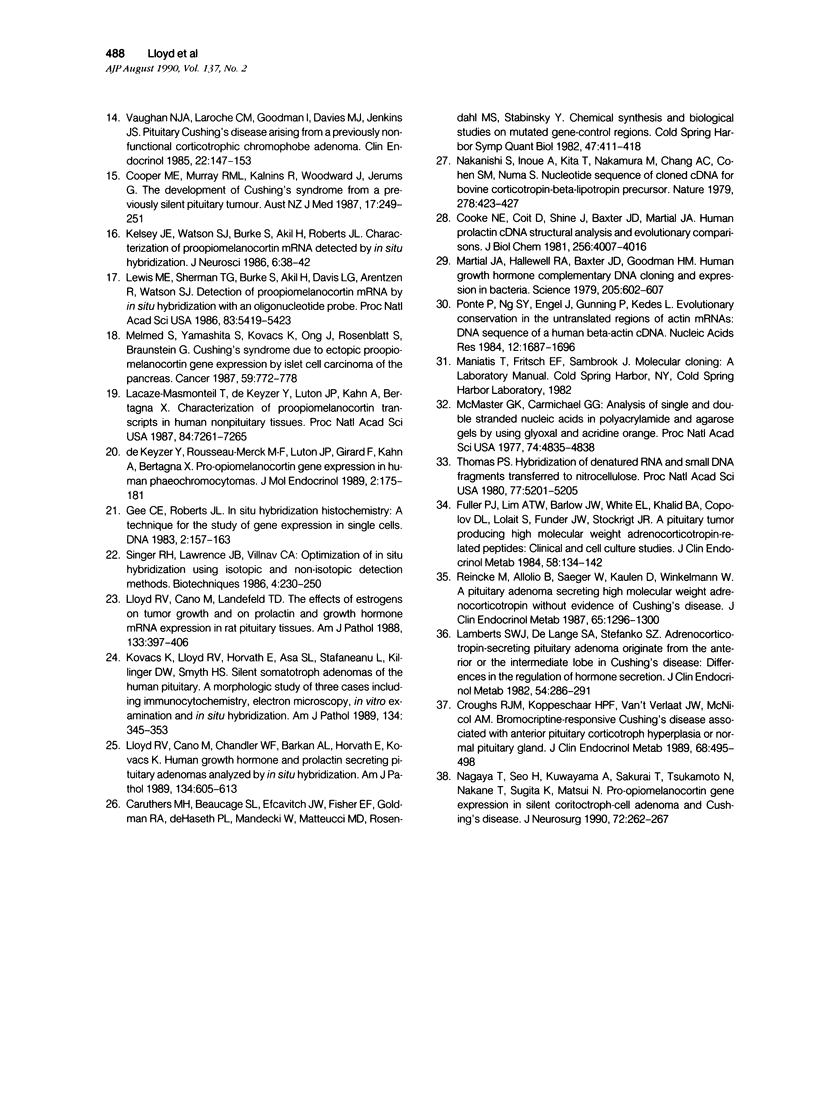
Images in this article
Selected References
These references are in PubMed. This may not be the complete list of references from this article.
- Asa S. L., Kovacs K., Tindall G. T., Barrow D. L., Horvath E., Vecsei P. Cushing's disease associated with an intrasellar gangliocytoma producing corticotrophin-releasing factor. Ann Intern Med. 1984 Dec;101(6):789–793. doi: 10.7326/0003-4819-101-6-789. [DOI] [PubMed] [Google Scholar]
- Carey R. M., Varma S. K., Drake C. R., Jr, Thorner M. O., Kovacs K., Rivier J., Vale W. Ectopic secretion of corticotropin-releasing factor as a cause of Cushing's syndrome. A clinical, morphologic, and biochemical study. N Engl J Med. 1984 Jul 5;311(1):13–20. doi: 10.1056/NEJM198407053110103. [DOI] [PubMed] [Google Scholar]
- Caruthers M. H., Beaucage S. L., Efcavitch J. W., Fisher E. F., Goldman R. A., deHaseth P. L., Mandecki W., Matteucci M. D., Rosendahl M. S., Stabinsky Y. Chemical synthesis and biological studies on mutated gene-control regions. Cold Spring Harb Symp Quant Biol. 1983;47(Pt 1):411–418. doi: 10.1101/sqb.1983.047.01.048. [DOI] [PubMed] [Google Scholar]
- Cooke N. E., Coit D., Shine J., Baxter J. D., Martial J. A. Human prolactin. cDNA structural analysis and evolutionary comparisons. J Biol Chem. 1981 Apr 25;256(8):4007–4016. [PubMed] [Google Scholar]
- Cooper M. E., Murray R. M., Kalnins R., Woodward J., Jerums G. The development of Cushing's syndrome from a previously silent pituitary tumour. Aust N Z J Med. 1987 Apr;17(2):249–251. doi: 10.1111/j.1445-5994.1987.tb00055.x. [DOI] [PubMed] [Google Scholar]
- Croughs R. J., Koppeschaar H. P., van't Verlaat J. W., McNicol A. M. Bromocriptine-responsive Cushing's disease associated with anterior pituitary corticotroph hyperplasia or normal pituitary gland. J Clin Endocrinol Metab. 1989 Feb;68(2):495–498. doi: 10.1210/jcem-68-2-495. [DOI] [PubMed] [Google Scholar]
- Fuller P. J., Lim A. T., Barlow J. W., White E. L., Khalid B. A., Copolov D. L., Lolait S., Funder J. W., Stockigt J. R. A pituitary tumor producing high molecular weight adrenocorticotropin-related peptides: clinical and cell culture studies. J Clin Endocrinol Metab. 1984 Jan;58(1):134–142. doi: 10.1210/jcem-58-1-134. [DOI] [PubMed] [Google Scholar]
- Gee C. E., Roberts J. L. In situ hybridization histochemistry: a technique for the study of gene expression in single cells. DNA. 1983;2(2):157–163. doi: 10.1089/dna.1983.2.157. [DOI] [PubMed] [Google Scholar]
- Gogel E. L., Salber P. R., Tyrrell J. B., Rosenblum M. L., Findling J. W. Cushing's disease in a patient with a 'nonfunctioning' pituitary tumor. Spontaneous development and remission. Arch Intern Med. 1983 May;143(5):1040–1042. [PubMed] [Google Scholar]
- Hassoun J., Charpin C., Jaquet P., Lissitzky J. C., Grisoli F., Toga M. Corticolipotropin immunoreactivity in silent chromophobe adenomas: a light and electron microscopic study. Arch Pathol Lab Med. 1982 Jan;106(1):25–30. [PubMed] [Google Scholar]
- Horvath E., Kovacs K., Killinger D. W., Smyth H. S., Platts M. E., Singer W. Silent corticotropic adenomas of the human pituitary gland: a histologic, immunocytologic, and ultrastructural study. Am J Pathol. 1980 Mar;98(3):617–638. [PMC free article] [PubMed] [Google Scholar]
- Horvath E., Kovacs K., Smyth H. S., Killinger D. W., Scheithauer B. W., Randall R., Laws E. R., Jr, Singer W. A novel type of pituitary adenoma: morphological features and clinical correlations. J Clin Endocrinol Metab. 1988 Jun;66(6):1111–1118. doi: 10.1210/jcem-66-6-1111. [DOI] [PubMed] [Google Scholar]
- Kelsey J. E., Watson S. J., Burke S., Akil H., Roberts J. L. Characterization of proopiomelanocortin mRNA detected by in situ hybridization. J Neurosci. 1986 Jan;6(1):38–42. doi: 10.1523/JNEUROSCI.06-01-00038.1986. [DOI] [PMC free article] [PubMed] [Google Scholar]
- Kovacs K., Horvath E., Bayley T. A., Hassaram S. T., Ezrin C. Silent corticotroph cell adenoma with lysosomal accumulation and crinophagy. A distinct clinicopathologic entity. Am J Med. 1978 Mar;64(3):492–499. doi: 10.1016/0002-9343(78)90236-x. [DOI] [PubMed] [Google Scholar]
- Kovacs K., Lloyd R., Horvath E., Asa S. L., Stefaneanu L., Killinger D. W., Smyth H. S. Silent somatotroph adenomas of the human pituitary. A morphologic study of three cases including immunocytochemistry, electron microscopy, in vitro examination, and in situ hybridization. Am J Pathol. 1989 Feb;134(2):345–353. [PMC free article] [PubMed] [Google Scholar]
- Lacaze-Masmonteil T., de Keyzer Y., Luton J. P., Kahn A., Bertagna X. Characterization of proopiomelanocortin transcripts in human nonpituitary tissues. Proc Natl Acad Sci U S A. 1987 Oct;84(20):7261–7265. doi: 10.1073/pnas.84.20.7261. [DOI] [PMC free article] [PubMed] [Google Scholar]
- Lamberts S. W., de Lange S. A., Stefanko S. Z. Adrenocorticotropin-secreting pituitary adenomas originate from the anterior or the intermediate lobe in Cushing's disease: differences in the regulation of hormone secretion. J Clin Endocrinol Metab. 1982 Feb;54(2):286–291. doi: 10.1210/jcem-54-2-286. [DOI] [PubMed] [Google Scholar]
- Lewis M. E., Sherman T. G., Burke S., Akil H., Davis L. G., Arentzen R., Watson S. J. Detection of proopiomelanocortin mRNA by in situ hybridization with an oligonucleotide probe. Proc Natl Acad Sci U S A. 1986 Aug;83(15):5419–5423. doi: 10.1073/pnas.83.15.5419. [DOI] [PMC free article] [PubMed] [Google Scholar]
- Lloyd R. V., Cano M., Chandler W. F., Barkan A. L., Horvath E., Kovacs K. Human growth hormone and prolactin secreting pituitary adenomas analyzed by in situ hybridization. Am J Pathol. 1989 Mar;134(3):605–613. [PMC free article] [PubMed] [Google Scholar]
- Lloyd R. V., Cano M., Landefeld T. D. The effects of estrogens on tumor growth and on prolactin and growth hormone mRNA expression in rat pituitary tissues. Am J Pathol. 1988 Nov;133(2):397–406. [PMC free article] [PubMed] [Google Scholar]
- Lloyd R. V., Chandler W. F., McKeever P. E., Schteingart D. E. The spectrum of ACTH-producing pituitary lesions. Am J Surg Pathol. 1986 Sep;10(9):618–626. doi: 10.1097/00000478-198609000-00004. [DOI] [PubMed] [Google Scholar]
- Martial J. A., Hallewell R. A., Baxter J. D., Goodman H. M. Human growth hormone: complementary DNA cloning and expression in bacteria. Science. 1979 Aug 10;205(4406):602–607. doi: 10.1126/science.377496. [DOI] [PubMed] [Google Scholar]
- McKeever P. E., Koppelman M. C., Metcalf D., Quindlen E., Kornblith P. L., Strott C. A., Howard R., Smith B. H. Refractory Cushing's disease caused by multinodular ACTH-cell hyperplasia. J Neuropathol Exp Neurol. 1982 Sep;41(5):490–499. doi: 10.1097/00005072-198209000-00002. [DOI] [PubMed] [Google Scholar]
- McMaster G. K., Carmichael G. G. Analysis of single- and double-stranded nucleic acids on polyacrylamide and agarose gels by using glyoxal and acridine orange. Proc Natl Acad Sci U S A. 1977 Nov;74(11):4835–4838. doi: 10.1073/pnas.74.11.4835. [DOI] [PMC free article] [PubMed] [Google Scholar]
- Melmed S., Yamashita S., Kovacs K., Ong J., Rosenblatt S., Braunstein G. Cushing's syndrome due to ectopic proopiomelanocortin gene expression by islet cell carcinoma of the pancreas. Cancer. 1987 Feb 15;59(4):772–778. doi: 10.1002/1097-0142(19870215)59:4<772::aid-cncr2820590418>3.0.co;2-h. [DOI] [PubMed] [Google Scholar]
- Nagaya T., Seo H., Kuwayama A., Sakurai T., Tsukamoto N., Nakane T., Sugita K., Matsui N. Pro-opiomelanocortin gene expression in silent corticotroph-cell adenoma and Cushing's disease. J Neurosurg. 1990 Feb;72(2):262–267. doi: 10.3171/jns.1990.72.2.0262. [DOI] [PubMed] [Google Scholar]
- Nakanishi S., Inoue A., Kita T., Nakamura M., Chang A. C., Cohen S. N., Numa S. Nucleotide sequence of cloned cDNA for bovine corticotropin-beta-lipotropin precursor. Nature. 1979 Mar 29;278(5703):423–427. doi: 10.1038/278423a0. [DOI] [PubMed] [Google Scholar]
- Ponte P., Ng S. Y., Engel J., Gunning P., Kedes L. Evolutionary conservation in the untranslated regions of actin mRNAs: DNA sequence of a human beta-actin cDNA. Nucleic Acids Res. 1984 Feb 10;12(3):1687–1696. doi: 10.1093/nar/12.3.1687. [DOI] [PMC free article] [PubMed] [Google Scholar]
- Reincke M., Allolio B., Saeger W., Kaulen D., Winkelmann W. A pituitary adenoma secreting high molecular weight adrenocorticotropin without evidence of Cushing's disease. J Clin Endocrinol Metab. 1987 Dec;65(6):1296–1300. doi: 10.1210/jcem-65-6-1296. [DOI] [PubMed] [Google Scholar]
- Schteingart D. E., Lloyd R. V., Akil H., Chandler W. F., Ibarra-Perez G., Rosen S. G., Ogletree R. Cushing's syndrome secondary to ectopic corticotropin-releasing hormone-adrenocorticotropin secretion. J Clin Endocrinol Metab. 1986 Sep;63(3):770–775. doi: 10.1210/jcem-63-3-770. [DOI] [PubMed] [Google Scholar]
- Thomas P. S. Hybridization of denatured RNA and small DNA fragments transferred to nitrocellulose. Proc Natl Acad Sci U S A. 1980 Sep;77(9):5201–5205. doi: 10.1073/pnas.77.9.5201. [DOI] [PMC free article] [PubMed] [Google Scholar]
- Tyrrell J. B., Brooks R. M., Fitzgerald P. A., Cofoid P. B., Forsham P. H., Wilson C. B. Cushing's disease. Selective trans-sphenoidal resection of pituitary microadenomas. N Engl J Med. 1978 Apr 6;298(14):753–758. doi: 10.1056/NEJM197804062981401. [DOI] [PubMed] [Google Scholar]
- Vaughan N. J., Laroche C. M., Goodman I., Davies M. J., Jenkins J. S. Pituitary Cushing's disease arising from a previously non-functional corticotrophic chromophobe adenoma. Clin Endocrinol (Oxf) 1985 Feb;22(2):147–153. doi: 10.1111/j.1365-2265.1985.tb01076.x. [DOI] [PubMed] [Google Scholar]
- de Keyzer Y., Rousseau-Merck M. F., Luton J. P., Girard F., Kahn A., Bertagna X. Pro-opiomelanocortin gene expression in human phaeochromocytomas. J Mol Endocrinol. 1989 May;2(3):175–181. doi: 10.1677/jme.0.0020175. [DOI] [PubMed] [Google Scholar]



